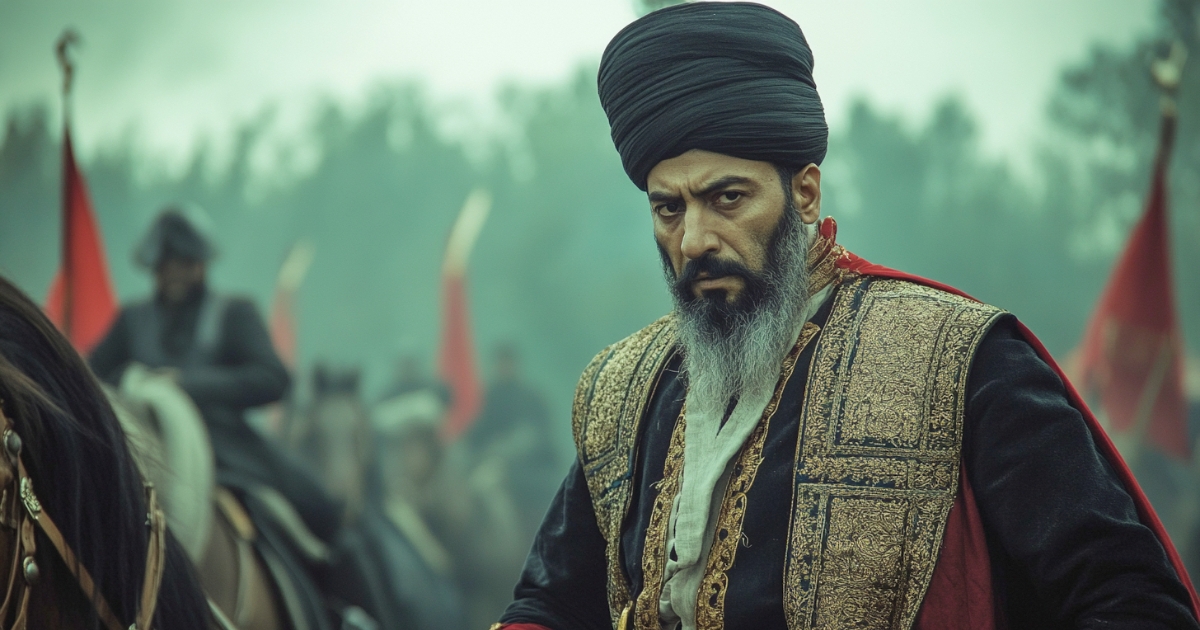In the early 19th century, Egypt, a vassal state of the Ottoman Empire, witnessed the rise of an ambitious leader named Muhammad Ali. His emergence breathed new life into a stagnant Egypt, marking a significant turning point that set the country on a path toward modernization.
This article explores Muhammad Ali’s role in Egypt’s modernization. His reforms spanned military, economic, and educational spheres, with impacts that resonate in contemporary Egypt. By examining his strategies, challenges, achievements, and limitations, we can gain insight into the issues faced by 19th-century Egypt and how one leader sought to address them.
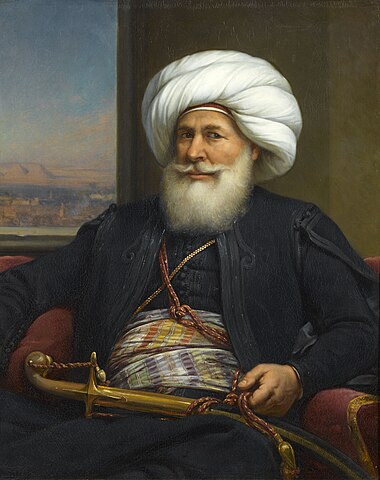
Muhammad Ali Pasha (1769-1849), who spearheaded Egypt’s modernization. His reforms encompassed military, economic, and educational sectors. By Auguste Couder
- Muhammad Ali’s Background and Rise to Power
- Military Reforms and Centralization
- Economic Reforms and Industrial Promotion
- Educational Reforms and Westernization Policy
- Tensions with the Ottoman Empire and Moves Toward Independence
- Negotiations with Western Powers
- The Impact of Muhammad Ali’s Reforms
- Conclusion
Muhammad Ali’s Background and Rise to Power
Born in 1769 in what is now Greek Macedonia, Muhammad Ali was the son of an Ottoman local official. He joined the Ottoman army at a young age, demonstrating military talent. In 1798, he was dispatched to Egypt to counter Napoleon’s expedition, a move that would dramatically alter Egypt’s history.
His ascent in Egypt was rapid. Skillfully exploiting the chaos following Napoleon’s withdrawal, he navigated diplomatic relations between the Ottoman Empire and the Mamluks. In 1805, backed by popular support, he secured the position of Governor of Egypt from the Ottoman Empire. He subsequently eliminated the Mamluk forces, becoming Egypt’s de facto ruler.
Military Reforms and Centralization
Muhammad Ali’s first focus was military reform. Building a strong military force was crucial for him as he sought effective independence while nominally under Ottoman rule.
He invited military advisors from the West, particularly France, to organize and train a modern army. He established a disciplined standing army to replace the irregular forces, introduced modern weapons, and founded military schools to educate officers.
These military reforms became the starting point for Egypt’s overall modernization. Specifically, military industries such as weapons factories and shipyards established in Cairo laid the foundation for Egypt’s industrialization. For instance, the Bulaq weapons factory, established in 1829, became the largest industrial facility in the Middle East at the time, producing artillery and small arms. The shipyard in Alexandria enabled the construction of large warships, significantly strengthening Egypt’s naval power.
Moreover, military schools pioneered Western-style education, teaching subjects like mathematics, physics, and engineering. The individuals educated in these schools would later play crucial roles in Egypt’s modernization.
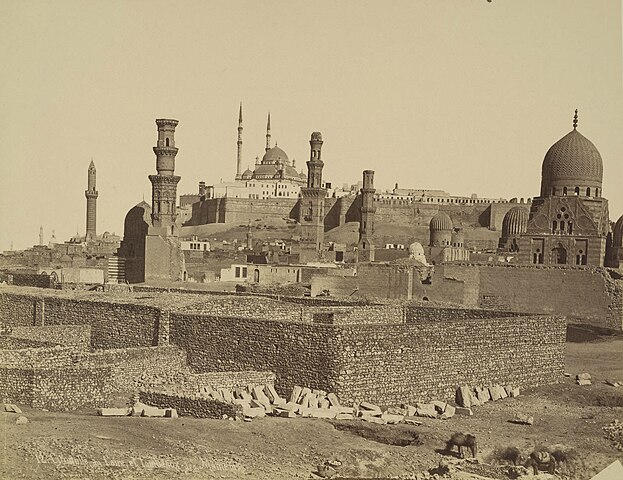
The Cairo Citadel and Muhammad Ali Mosque in the late 19th century. Muhammad Ali used this citadel as a base to promote military reforms and modernize the Egyptian army. The mosque he built became a symbol of his power and ambition.
Economic Reforms and Industrial Promotion
Maintaining a powerful army required stable financial resources. Muhammad Ali addressed this challenge by fundamentally restructuring Egypt’s economy.
He focused on cotton cultivation, developing large-scale cotton plantations that leveraged the Nile Delta’s suitability for long-staple cotton. This aligned with the demand from Britain’s textile industry, which was flourishing due to the Industrial Revolution, and cotton became Egypt’s primary export.
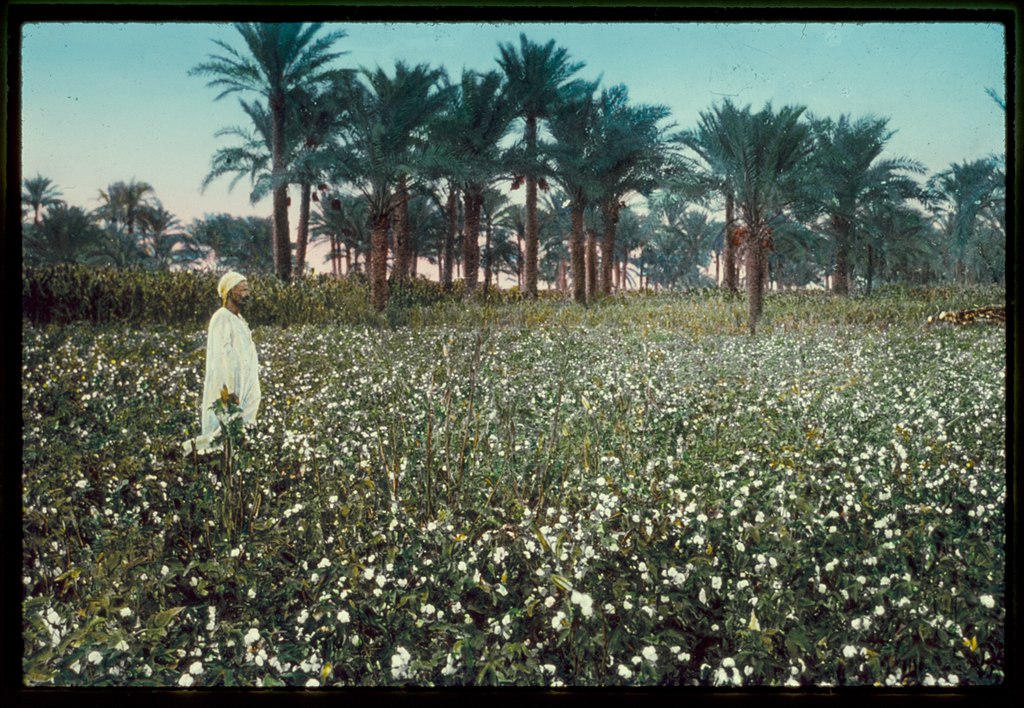
Cotton cultivation in Egypt in the mid-20th century. The cotton industry, introduced by Muhammad Ali’s economic reforms in the early 19th century, remained a crucial pillar of Egypt’s economy for over a century. By Matson Collection – Library of Congress Catalog
However, Muhammad Ali’s economic reforms weren’t limited to cotton cultivation. He implemented large-scale irrigation projects to expand arable land and increase productivity. For example, the construction of the Delta Barrage allowed for more efficient use of Nile water, significantly boosting agricultural production.
He also focused on developing state-owned industries. Various industries, including armaments factories, shipyards, and sugar refineries, were established under state leadership. These formed the basis for modern industrial production and drove Egypt’s industrialization.
Yet, these economic reforms had both positive and negative consequences. While the establishment of an export-oriented economy centered on cotton integrated Egypt into the global economic system, it also created economic vulnerabilities. For instance, during the global economic crisis of 1837, the collapse of cotton prices severely impacted Egypt’s economy. Additionally, while state-led industrialization brought rapid economic development in the short term, it suppressed private sector growth, ultimately compromising the economy’s flexibility in the long run.
Educational Reforms and Westernization Policy
Muhammad Ali believed that Western knowledge and technology were essential for building a modern nation. Consequently, he implemented bold educational reforms and a policy of Westernization.
He introduced a Western-style school system, starting with military schools and followed by specialized higher education institutions such as medical schools, engineering schools, and agricultural schools. In these schools, classes were conducted in French or Italian, teaching the latest Western knowledge.
Furthermore, he sent many young people to study in Europe. Upon their return, these students became the driving force behind Egypt’s modernization. They not only brought back technical knowledge and skills but also absorbed Western ideas and values, introducing new perspectives to Egyptian society.
These educational reforms created a new class of intellectuals in Egypt. Those who received Western-style education would later become the driving force behind Egyptian nationalism and modernization movements.
Tensions with the Ottoman Empire and Moves Toward Independence
As Muhammad Ali’s reforms progressed, relations with the Ottoman Empire gradually became strained. The Ottoman Empire grew increasingly wary of Egypt, which, while nominally a vassal state, was behaving effectively as an independent nation.
In 1831, Muhammad Ali advanced his army into Syria, engaging in full-scale confrontation with the Ottoman Empire. Initially successful, his forces advanced as far as Anatolia, but European powers’ intervention forced their withdrawal.
This Syrian expedition clearly demonstrated Muhammad Ali’s pursuit of de facto independence. While he never formally declared independence, his actions significantly deviated from Ottoman control. For instance, he developed independent foreign policies and engaged in direct negotiations with European countries, essentially behaving as an independent state.
Ultimately, due to the intervention of European powers, Egypt did not achieve full independence. However, the London Treaty of 1841 recognized hereditary rule of Egypt by Muhammad Ali’s family, securing a special status within the Ottoman Empire. While falling short of complete independence, this meant Egypt had gained substantial autonomy.
Negotiations with Western Powers
Muhammad Ali’s modernization policies were implemented within a complex relationship with Western powers. Relations with France and Britain, in particular, were crucial factors shaping Egypt’s future.
He maintained relatively good relations with France, inviting many French engineers and educators. French cultural influence was strong, with the French language spreading among Egypt’s elite.
Relations with Britain were more complex. While there were strong economic ties through the cotton trade, there were frequent political conflicts. Particularly intense negotiations revolved around the construction of the Suez Canal.
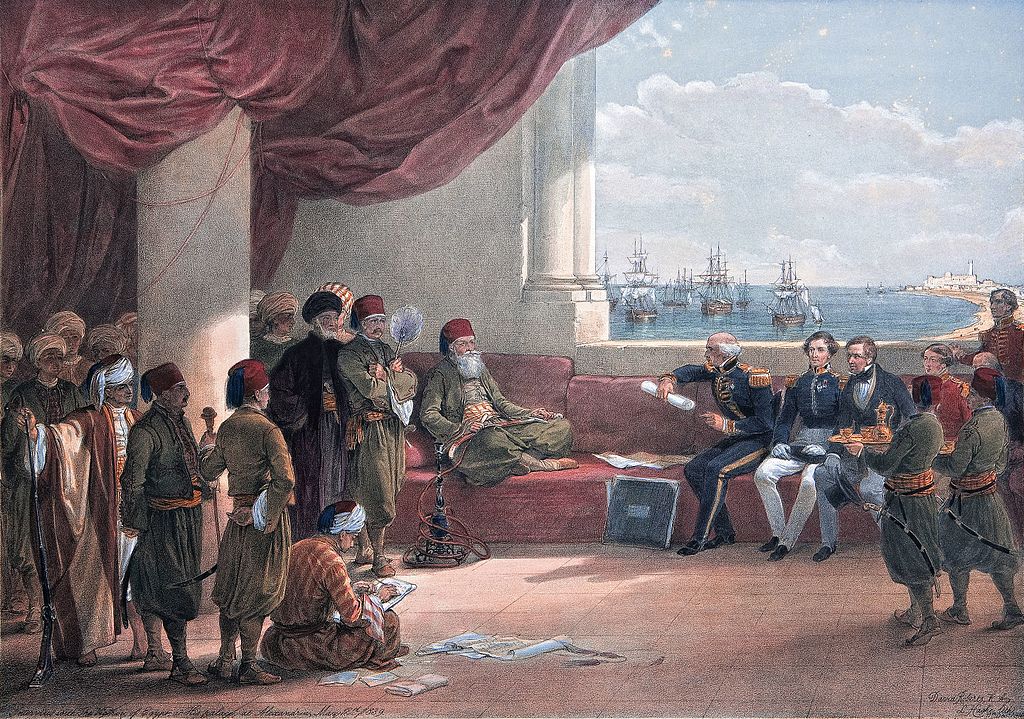
‘Interview with Mehemet Ali in his Palace at Alexandria’ by David Roberts and Louis Haghe. This painting depicts Muhammad Ali directly negotiating with Western visitors, symbolically representing his foreign policy and relations with the West. By David Roberts
Muhammad Ali faced the challenging task of steering Egypt towards self-reliance and independence while leveraging Western power. His Westernization policies, while leading Egypt towards modernization, also resulted in increased influence from Western powers.
The Impact of Muhammad Ali’s Reforms
Muhammad Ali’s reforms brought about significant changes in Egyptian society. In the short term, there were visible achievements such as strengthened military power, economic modernization, and improved education levels.
However, the impact was more long-term. His reforms laid the foundation for a modern Egyptian state and sowed the seeds of nationalism. The new elite class educated in Western-style schools would become the driving force behind Egypt’s politics and culture in the 20th century.
On the other hand, his reforms had limitations. The centralized governance system hindered the development of democratic institutions. Additionally, the cotton-centric economic structure created vulnerabilities in Egypt’s economy.
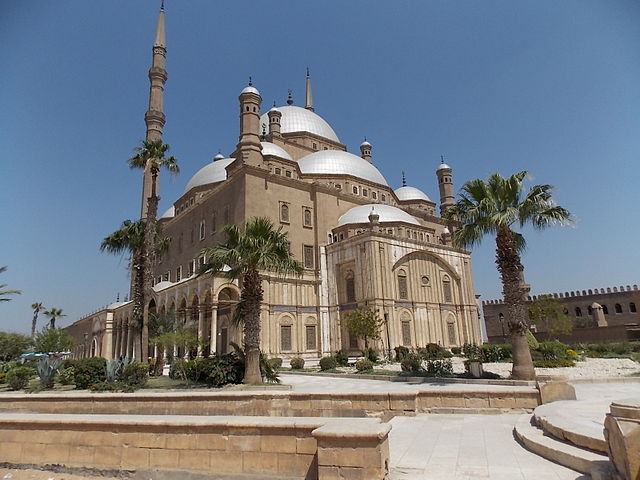
The Muhammad Ali Mosque in Cairo. This architectural masterpiece symbolizes his legacy and represents the fusion of Egypt’s modernization and tradition. Ahmed Ragheb 97, CC BY-SA 3.0
Conclusion
Muhammad Ali’s legacy continues to significantly influence modern Egypt. His reforms elevated Egypt to a central position in the Middle East region and became a model for modernization in the Arab world.
The lessons from his strategies are diverse and relevant today. The possibilities and limitations of state-led modernization, the challenges of balancing Westernization with national traditions, and the responsibilities of a regional power in international relations are issues that many developing countries still grapple with today.
About 200 years have passed since Muhammad Ali’s era, yet Egypt continues to walk the path of modernization he initiated. Reflecting on his achievements and setbacks not only teaches us about history but also provides insights into addressing contemporary challenges. The endeavors of Muhammad Ali, the lion who awakened Egypt, continue to speak volumes to us today.
